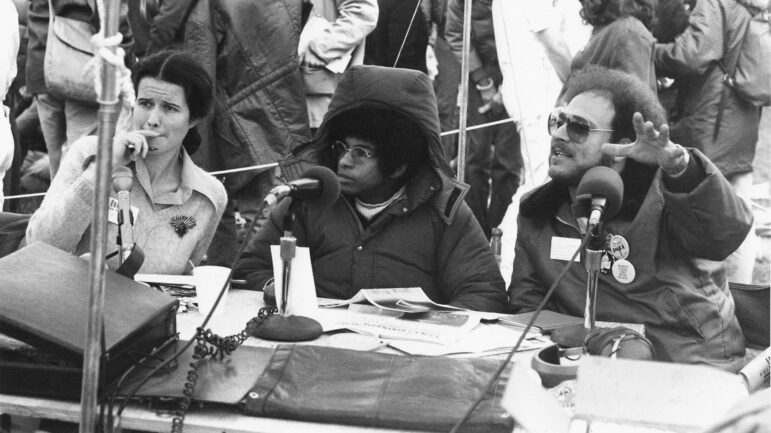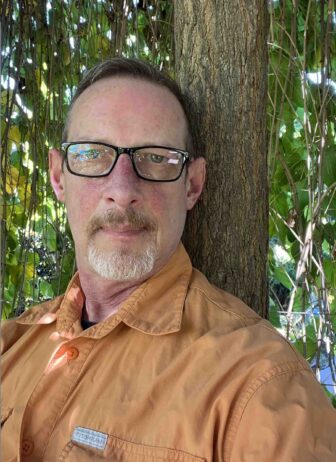How ‘This Way Out’ is preserving its collection of historic audio from the LGBTQ movement

Bettman Collection / Getty Images
Thousands of protestors marched down Pennsylvania Avenue in Washington, D.C., in October 1979 for the first National March on Washington for Lesbian and Gay Rights.
What began as an idea at the 1987 March on Washington for Gay and Lesbian Rights, This Way Out: The International LGBTQ Radio Magazine, debuted nationally on April 1, 1988, via the Public Radio Satellite System. Twenty-six stations initially responded to the promotional postcard inviting them to pick up the new series. Thirty-four years and 1,784 programs later, the magazine-style show exploring contemporary LGBTQ issues and historical events in the queer rights movement is distributed on multiple platforms and broadcast by 183 radio stations and outlets worldwide.
Under the direction of Josh Shepperd, assistant professor at the University of Colorado Boulder and a Sound Fellow of the Library of Congress National Recording Preservation Board, the Radio Preservation Task Force’s Sound Submissions program has provided the opportunity to preserve and make the entire collection accessible for research. “This important project diversifies and expands our primary source record,” he said.
Sound Submissions is a digital humanities program in the Recorded Sound Section of the Library of Congress’s National Audio-Visual Conservation Center. Sound Submissions first convened last fall and established a curatorial team to facilitate donations of digitized recordings and associated metadata for ingestion into the Library’s permanent digital archive. This Way Out was selected as one of the first-year collections in the program.
The award-winning, half-hour magazine-style program features “NewsWrap,” a summary of some of the major events in or affecting the queer community around the world, in-depth coverage of major events, interviews with key queer figures plus segments on music, literature and entertainment.
This Way Out’s stalwart producers, Lucia Chappelle and Greg Gordon, have guided development of this radio production from razor blade editing on reel-to-reel tape to today’s digital world. To tell the full story of the series’ origins, we have to go back to the 1974 when KPFK in Los Angeles created space for a weekly gay and lesbian show. Lucia and Greg were involved in the show that began as the Gay Radio Collective, and later became IMRU Radio Collective and still airs weekly on KPFK.
‘We drew all these people together’
Greg Gordon came out in the late 1960s and early ‘70s. By 1974, he was volunteering at what was then called the Gay Community Services Center in downtown LA, where workshops and rap groups helped raise consciousness and provide support.
In a 2021 interview for This Way Out’s live-streamed James Baldwin Teach-In, Gordon said he started doing radio for the LGBTQ community after KPFK posted a notice that it was looking for new volunteers. “At the time, there was a once-a-month lesbian show on and a once-a-month gay men’s show,” he said. “Your’s truly and two other guys signed up, and we did our first show in August of 1974. It was live with listener phone-in calls.”
Chappelle was working the KPFK switchboard on the afternoon of the first broadcast. “I got a call and this woman’s very delicate voice said, ‘I’m 80 years old. And I’m a lesbian. I’ve never told anyone that before and I wanted to tell someone today.’ She just needed to be heard and … identified,” Chappelle said. “Those are all the reasons why these kinds of shows still need to exist.”
Nearly five years later, on October 14, 1979, Chappelle and Gordon joined Moira Rankin, host of Sophie’s Parlour Media Collective at Pacifica’s WPFW in Washington, D.C., to co-anchor the broadcast of the first National March on Washington for Lesbian and Gay Rights for Pacifica.
In a 2021 interview, Chappelle told Lynn Ballen of KPFK’s Feminist Magazine that Bill Bogan was the “hero of the day.” Bogan was producer and host of Friends, the gay and lesbian show at Pacifica’s WPFW in Washington. For his day job, Bogan worked for NPR. He talked NPR into footing the bill for covering the march if Moira Rankin, also an NPR staffer, was included as an anchor.

People traveled from San Francisco, Los Angeles, New York and Boston to help with the coverage. Bruce Pennington, one of the production assistants, opened his big house to everyone, Chappelle recalled. Sleeping bags for about a dozen people spread across his living room floor. The team set up roundtables to figure out who would do what. And everybody had little field packs. “We figured out ways to have anchors at the table and people in the crowd keeping track of everything that was happening,” she said.
The 1979 Pacifica broadcasts are preserved and freely available at the Internet Archive. For the record, the coverage was produced by Bogan and directed by Wesley Horner. The sound engineers were Skip Pizzi, Eric Epstein, Eileen Griffin and Lee Garlington. The production assistants were Alex Van Oss, David Aiken, Joan Sprague, Jane Clewe, Hedy Swanson, John Neill, Fred Goldhammer, Art Aratin, Fred Brungard and Pennington. Wandering through the crowd with remote mics were David Wynyard, Amy Sands and Isaac Jackson.
By 1987 Chappelle and Gordon had become radio veterans. The Pacifica network hired them to organize and co-anchor its coverage of the second National March on Washington for Lesbian and Gay Rights.
“The biggest thing I remember about the 1987 March on Washington was that we had depended upon a guy from WPFW to shore up the technical stuff,” Gordon said. “The audio would be fed to the station to be uploaded to the satellite, which at the time was the way National Public Radio and community radio programs were distributed.”
But when the production team arrived in Washington, the line wasn’t there. In the end, someone from WBAI, Pacifica’s New York City station, caught a train to D.C. to deliver tape decks. The rally coverage was recorded and, hour by hour, a bicyclist delivered the reel-to-reel tapes to WPFW, where the audio was uploaded to PRSS, Gordon said. “That’s how that live coverage was distributed — in hourly recorded segments delivered by bicycle.”
Chappelle described how the marches inspired the team to create This Way Out: “We drew all these people together” and realized “we could make a show with all these reporters feeding their material,” she said. This was in the early days of PRSS, when people were learning how to share programs on the satellite system instead of mailing cassettes to each other.
‘Digital first’ preservation
Fast forward to today and the incredible opportunity to preserve the legacy that grew out of those marches and the many reporters, guests and volunteers who contributed to This Way Out over the decades.
The collection reflects the technical evolution of radio production. It is divided between reel-to-reel tapes from 1988 to 2000 that are held in the Pacifica Radio Archives on-site and off-site storage facilities and digital files from 2000 to present, which have been saved on various digital storage devices, including Jaz discs and external hard drives sequestered in producer’s closets.
The reel-to-reel tape collection exists because producers of This Way Out had the foresight to secure the tapes in the Pacifica Program Service/Pacifica Radio Archives for safekeeping and distribution via Pacifica’s affiliate satellite system.
For the first phase of preserving the collection for Sound Submissions, we’ll focus on the “born digital” programs. Ironically, this presents more challenges than the reel-to-reel tapes because we’ll have to retrieve the content from obsolete Jaz discs and multiple hard drives with multiple formats to excavate.
While Chappelle organizes the digital files covering programs from 2010 to 2022 that are stored on computers, we’re collaborating with the University of California in Los Angeles School of Education and Information Studies Center for Preservation of Audiovisual Heritage to retrieve about 140 episodes that were stored on obsolete Iomega Jaz disks, with original air dates from 1999 and 2011.
For phase II, we will backtrack to the reel-to-reel tapes to digitize them and enter the files into the workflow of the Sound Submissions project. Only a dozen programs have been transferred from the reel-to-reel tape era (1988-1999) to digital format.
In the earliest example from June 24, 1991, Mitchell Hartman reports on 7th International Conference on AIDS in Florence, Italy, where HIV-positive participants were barred from entry; Pedro Preciado covers planning of a solidarity conference of the International Lesbian and Gay Association in Acapulco, Mexico; and Cindy Friedman reads the San Francisco Times article “Preaching Against Theological Homophobia” by Robert Warren Cromey.
After 34 years of producing This Way Out, Gordon said feedback from listeners who are struggling with their identities is what motivates him to keep going. He remembered one person who said they listened to the show “on their headphones behind a closed bedroom door so no one would know,” and described how the show made them “feel okay — more okay — about myself.”

“This is probably true for a lot of us who do active work in the community in whatever capacity,” Gordon said. “We remember how challenging it was when we were coming out. And how much of a help having that lone supportive voice in the night, so to speak, tell us that we were not monsters. We were not sinful. We were not illegal. We were beautiful human beings just the way we were intended to be.”
“I know I’m educating people as well as supporting people and, you know, you can’t put a price on that,” he said.
Brian DeShazor is CEO of Overnight Productions, Inc., the nonprofit that produces This Way Out: The International LGBTQ Radio Magazine. He is an archives research associate for the Library of Congress Sound Submissions project of the National Recording Preservation Board. As director of the Pacifica Radio Archives (2000-2016) DeShazor received the NFCB Bader award for his contributions to public broadcasting. This Way Out is offered for free; its programs can be found on radio4all.net, Pacifica’s Audioport and SoundCloud, Stitcher and other podcast platforms.





